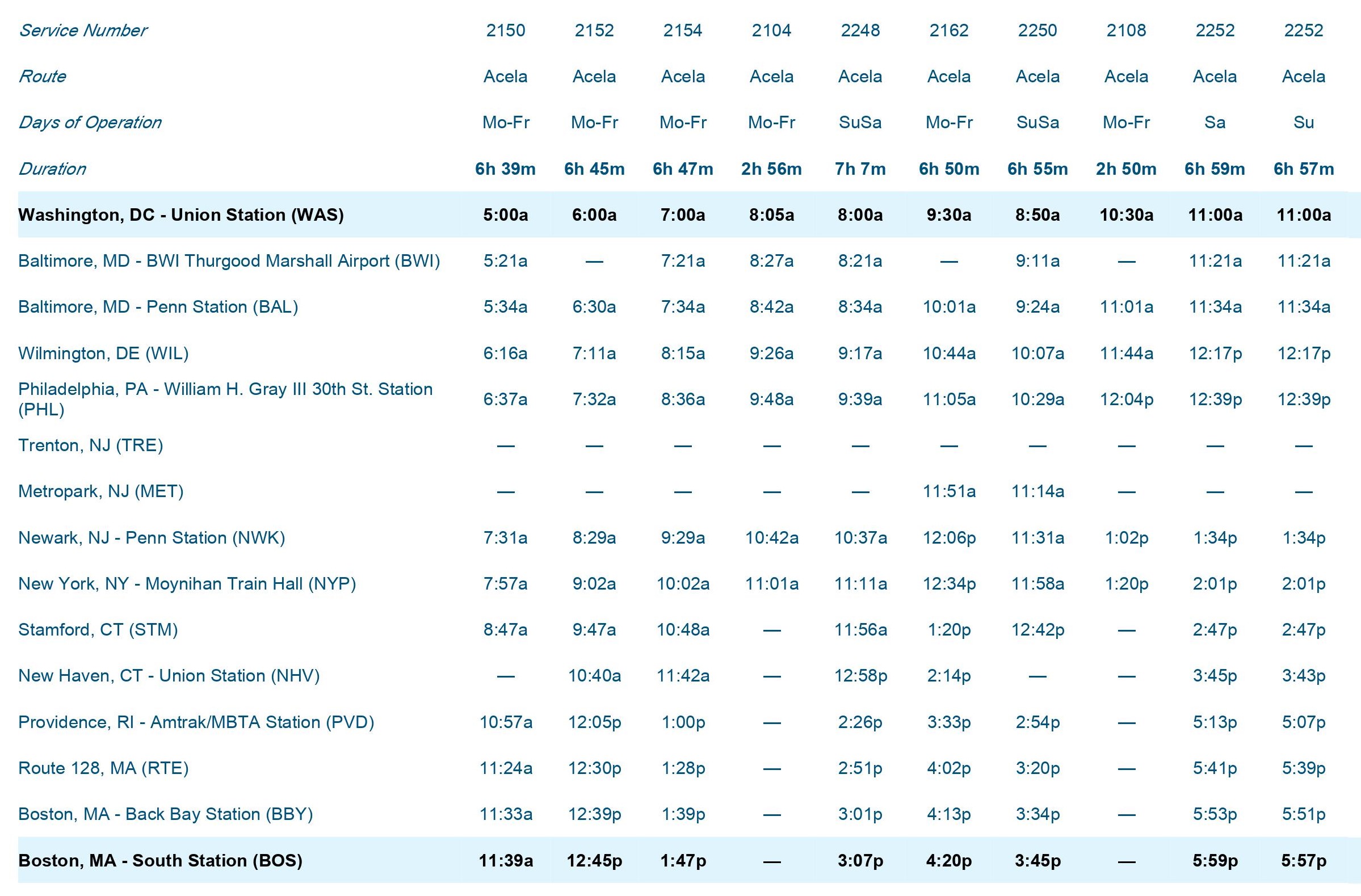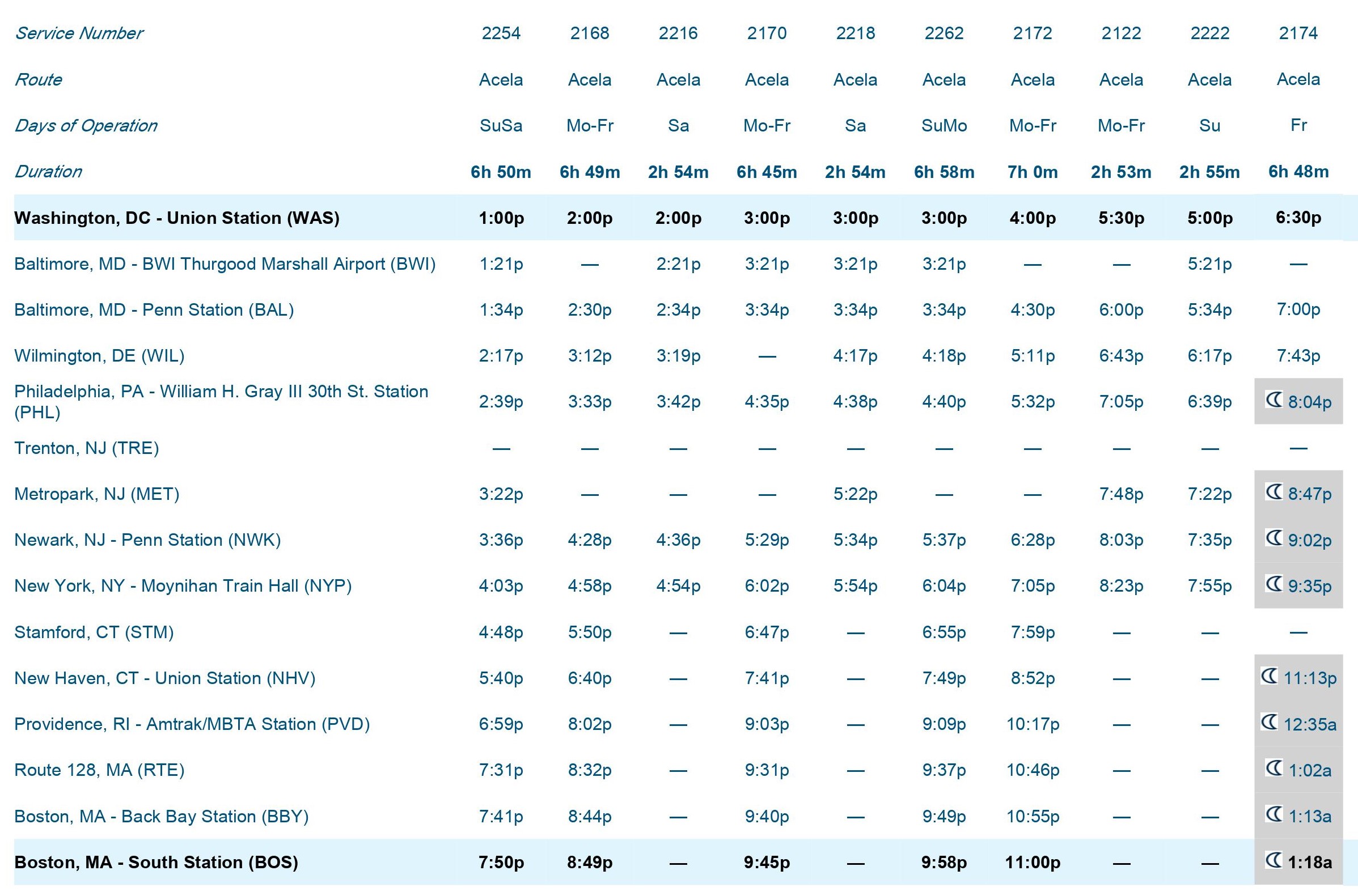Passenger train services • Main line services / Ticketing • Intercity • USA • Amtrak • Acela
➤ Similar operators: Avanti West Coast – Flixtrain – LNER – Lumo – ÖBB Railjet – WESTbahn
Note: For educational purpose only. This page is meant purely as a documentation tool and has no legal effect. It is not a substitute for the official page of the operating company, manufacturer or official institutions. It cannot be used for staff training, which is the responsibility of approved institutions and companies.
Read the full package on Amtrak Acela:
The company → Rolling stock → Train services → Economics
Summary
Acela is Amtrak’s premier high-speed rail service operating in the United States, specifically along the Northeast Corridor (NEC), which runs from Boston, Massachusetts, to Washington, D.C., with stops in major cities like New York City and Philadelphia. Acela trains are designed for business and first-class travel, offering faster service than other Amtrak trains on the same route due to their limited stops and high-speed capabilities.
The trains used for Acela service are part of the Acela Express fleet, which originally consisted of Bombardier-Alstom trainsets introduced in 2000. Each trainset includes a power car at each end and six passenger cars in between. These trains are capable of reaching speeds up to 150 mph (241 km/h) on certain track segments, although average speeds are lower due to track conditions and congestion.
Operator: Amtrak
Subsidiary / shareholders: 100% U.S. federal government
Sector: Passengers transport
Type of service: Main line
International transport: no
First services: 11 December 2000
Train type: Emu Acela Express, Avelia Liberty
Manufacturer(s): Bombardier, Alstom
Driver service: own
Officiel website: https://www.amtrak.com/acela-train
Social media: :
Similar companies : IC Deutsche Bahn – Railjet
In recent years, Amtrak has been introducing a new generation of Acela trains known as Avelia Liberty, built by Alstom. These next-generation high-speed trains feature improved acceleration, tilting technology for smoother rides through curves, greater energy efficiency, and enhanced passenger amenities. The Avelia Liberty trains are expected to replace the older Acela Express fleet and significantly improve the Acela service’s capacity and reliability.
Acela service is tailored for business travelers seeking speed and comfort, with onboard Wi-Fi, power outlets, quiet cars, and premium seating. It remains the fastest train service in the U.S. and a vital link between the East Coast’s economic and political hubs.
The definition of a high-speed train varies by region, but generally, it refers to trains that operate at speeds of at least 250 km/h (155 mph) on newly built lines and 200 km/h (124 mph) on upgraded lines. In Europe, for example, the UIC (International Union of Railways) considers a commercial speed of 250 km/h as the principal criterion for high-speed rail. In the United States, the definition can include trains operating at speeds ranging from 180 km/h (110 mph) to 240 km/h (150 mph).
➤ See the UIC definition
Regular route
➤ Boston – New Haven – New York – Philadelphia – Baltimore – Washington DC
Rolling stock (past and present)

Bombardier / Gec Alsthom
2000 – 2025

Alstom
2024 – …
Background
The Acela Express, commonly known as the Acela, is a so-called ‘high-speed’ train service operated by Amtrak, the public passenger train operator in the USA, on the Northeast Corridor between Boston, New York, Philadelphia and Washington DC.
Following the success of Japan’s newly inaugurated Shinkansen network, the High Speed Ground Transportation Act of 1965 authorised the US government to explore the creation of high-speed trains, leading to the introduction of the Metroliner ‘high-speed’ trains between Washington, D.C., and New York City in 1969, the predecessor of the Acela. During the 1980s, following the success of the Japanese concept and the TGV in France, the US Federal Railroad Administration was exploring the possibilities of creating high-speed trains in the United States, a country that had largely abandoned passenger rail transport in favour of cars and aviation. On 18 December 1991, five potential high-speed rail corridors were authorised, including the North-East corridor.
The ‘North-East Corridor’ (NEC)
In the early 1990s, Amtrak tested several high-speed trains from Europe on the North-East Corridor. An X 2000 trainset was leased from Sweden for trials from October 1992 to January 1993, followed by commercial revenue service between Washington and New York from February to May and August to September 1993. Siemens presented the ICE 1 trainset used by Deutsche Bahn in Germany, organising the ICE Train North America Tour, which began running on the Northeast Corridor on 3 July 1993.
All these tests enabled Amtrak to define a set of specifications for high-speed equipment to US standards and, in October 1994, Amtrak issued a call for tenders to manufacturers for a trainset capable of reaching 150 miles per hour (240 km/h). A consortium comprising Bombardier (75%) and GEC Alsthom (now Alstom) (25%) was selected in March 1996.
On 9 March 1999, Amtrak unveiled its plan for a train called the Acela Express, a high-speed train on the northeast corridor between Washington, D.C., and Boston.
Officially launched on 11 December 2000, this train operates on the North Eastern Corridor (NEC) of the United States, between Boston, New York, Philadelphia and Washington D.C. The NEC is currently the only line that is electrified and allows speeds of 200km/h on certain sections. The Acela looks like a European train.
In the meantime, the UIC has defined the term ‘high speed’ at world level. For the UIC, a minimum speed of 250 km/h is required to qualify as a ‘high-speed train’, which is closer to the standards practised in Europe and Japan. Amtrak’s Acela does not officially fall into the high-speed category, but the term is still used in everyday language, mainly for marketing purposes.
The American train is capable of reaching maximum speeds of 240 km/h over just 54.6 km of the 735 km route:
- Rhode Island: Between Kingston and Cranston, the Acela can reach its maximum speed of 240 km/h.
- Massachusetts: In certain areas around Mansfield, the train can also reach speeds of up to 240 km/h.
Speeds in excess of 160km/h are also possible on the following sections:
- Connecticut: Between New London and Old Saybrook, there are sections where speeds can reach up to 177 km/h (110 mph).
- Maryland: On the sections between Baltimore and Wilmington, speeds can reach up to 217 km/h (135 mph).
Outside these high-speed sections, train speed is often limited by track conditions, curves and congestion on the corridor, resulting in average speeds that are generally below maximum capacity. The overall average speed of the Acela, taking into account the whole route including stops, is around 132 km/h (82 mph).
Improvements and upgrades to the NEC aim to increase the sections where higher speeds can be maintained, potentially further reducing journey times in the future.
Acela rolling stock
Amtrak’s specifications included a requirement that the new trains be capable of speeds of 150mph (240km/h) and be able to withstand a collision with a freight train. Most of the US manufacturers who bid for the Acela were clearly unable to meet such structural requirements, due to the increased costs and complications involved in manufacturing the trains, and the need for these manufacturers to make significant technical changes to their standard designs.
In the end, only three qualified bidders, all European, remained in the running: ABB (builder of the Swedish X 2000 train), Siemens (builder of the ICE) and finally a consortium made up of Bombardier (builder of the LRC trains in Canada) and GEC Alsthom (builder of the French TGV and the first generation of Eurostar trains).
Acela services
The Acela (called Acela Express until September 2019) is Amtrak’s long-distance train service on the NEC between Washington D.C. and Boston with 13 intermediate stops, including Baltimore, New York City and Philadelphia. Acela trains are now the fastest in the US (and indeed the Americas), topping 170km/h over 80.3km of the full 735km route.
In the spring of 2024, for example, there were 7 round trips making the full Washington DC – Boston journey from Monday to Friday, plus an 8th in part-night service only on Friday evenings. There are 4 return trips on Saturdays and Sundays, plus a 5th only on Sunday afternoons:


On weekdays in Washington, there is a timetable from 5.00 am to 7.00 am (3 departures), then a departure at 9.30 am and then a significant ‘gap’ until 1.00 pm before a new timetable until 4.00 pm (4 departures), for the entire route.
The fastest train in the northbound direction described above is the first departure, the Acela 2150, which takes 6h39 to cover the 735 km and 10 intermediate stops, an average speed of 110.52 km/h. The Acela 2248 departing from Washington, with 11 intermediate stops, is the ‘slowest’, taking 7h07, or an average of 103.24 km/h.
Ridership and revenue on Acela trains
The Acela carried more than 2.9 million passengers in the 2023 financial year, just behind the slower and cheaper Northeast Regional, which carried more than 9 million passengers. Passenger numbers are down on the pre-pandemic peak of 3.55 million passengers in 2019, but this is a situation seen almost everywhere in the world.
Proof of the importance of this service is that in 2016, the $585 million in revenue represented 25% of Amtrak’s total turnover, which is far from negligible. By 2023, Amtrak explained that Acela trains had achieved an operating profit of $34 per passenger. However, this was down from $93 per passenger in 2019. 🟧
[TOP]
Main line • Intercity • USA • Amtrak • Lexical
